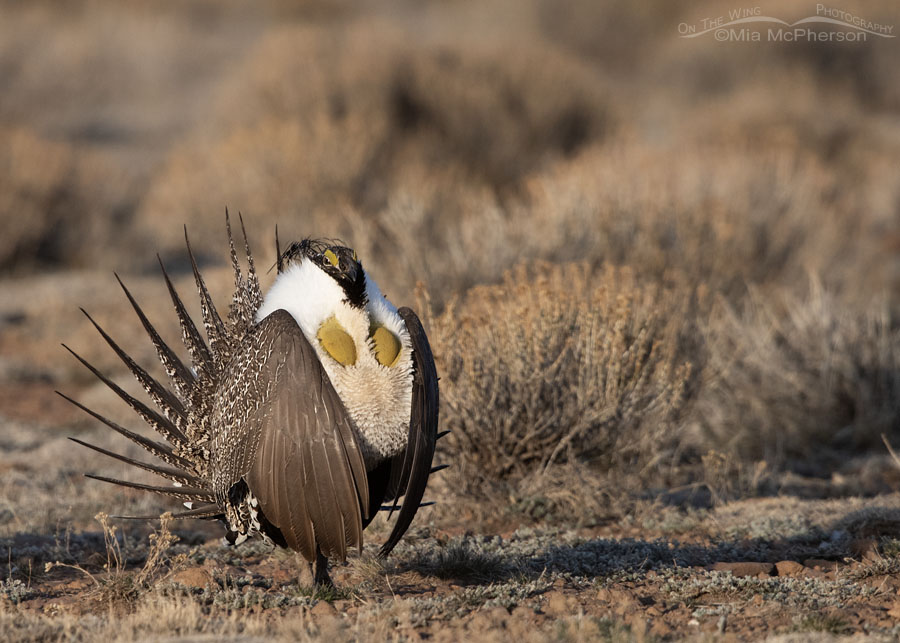If I could, I would wish that everyone, at least once in their lifetime, could visit a Greater Sage-Grouse lek while these fascinating birds are displaying.
 Dawn light on a male Greater Sage-Grouse – Nikon D810, f6.3, 1/1250, ISO 640, Nikkor 500mm VR with 1.4x TC, natural light
Dawn light on a male Greater Sage-Grouse – Nikon D810, f6.3, 1/1250, ISO 640, Nikkor 500mm VR with 1.4x TC, natural light
Of course, I wouldn’t want the grouse disturbed, but I think the courtship displays that happen on these leks might help more people see why we need to protect them and protect nature.
Greater Sage-Grouse perform one of the most amazing, mesmerizing mating displays of birds in North America.
The elaborate courtship displays of the Greater Sage-Grouse begin before first light. I could hear the pops and whistles that are created when the males inflate the yellow air sacs in their necks before there was enough light to photograph.
Watching the male Greater Sage-Grouse spar, dance, kick, twirl, nip, and shove each other was fascinating. There were times when I was near this lek that I needed to remind myself to take photos and not just watch the grouse displaying.
These birds are at risk. Oil and gas exploration in the sagebrush sea has disturbed them and their breeding cycles. They are completely dependent on sagebrush for food, to raise their young, and for protection.
We need to help the grouse survive, which is why I wish that just once in a lifetime, people could experience the wonder of Greater Sage-Grouse on their leks. Even if it is only to watch a movie about these birds instead of being there physically.
Without a doubt, I know that these birds are a national treasure.
Life is good.
Mia
Click here to see more of my Greater Sage-Grouse photos plus facts and information about this species.
Greater Sage-Grouse Lek Photography Guidelines
Anyone wishing to see this yearly ritual should arrive on the lek well before daybreak so as to not disturb the grouse.
Stay in your vehicle! Do not exit your vehicle to get closer or get a better shot.
If the grouse are disturbed and fly away they won’t be back again that day and no mating will occur.
You also need to be prepared to stay until the last bird finishes his display and leaves the lek for the sake of these birds. They face enough hurdles nowadays as it is. Please don’t be one of those hurdles.
Talk softly, don’t turn on your engine to get warm if you are in a vehicle. Pee before you get there. Dress warmly. Turn down the volume on your cell phone or set it to vibrate.
Additionally, on nights with a full moon it might be best to stay away from the leks because the grouse can and do display all night long. Don’t use flash. Or electronic playback of calls.
Always put the well being of the birds before the photos.





Here here . . . never disturb.
Those Grouse are definitely on my bucket list!
100% — all of it! I’ll probably never be “live at a lek,” so I treasure these posts — and the fantastic recordings you find to share with all of us.
I wish you would put this info on Birding in Utah and a couple of the Utah wildlife Photography sites. Someone posts great photos then people rush up to see and photograph them. I can’t count how many times I have been to the nearby lek and have a car load of people arrive late , jump out of the car, walking towards the birds while talking loudly. They are uneducated in lek etiquette.
April, I was booted out of the Birding in Utah Facebook group because years ago I shared a post about owls four HOURS before they changed the group rules about not posting owls. I’m fine with not being in the group, but what they did was wrong and arbitrary. Kind of snotty too.
That said, if you would like to share my post to the group, please feel free to do so. Share to any group you want!
Thanks Mia, well put and a beautiful picture!!
Thank you Mia
I think I have seen a show on PBS and saw grouse during their mating season. Birds are fascinating. All of your tips should be used when photographing.
Amen…. Amen…